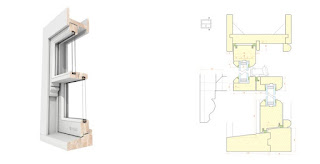The Future of Glazing Bars Production with Window Glazing Bars and Advanced Machinery
The vertical or horizontal bars that split a window into smaller panes or portions are called Window Glazing Bars. In both conventional and contemporary window designs, these bars fulfill practical and decorative roles. In terms of functionality, glazing bars support the glass panes structurally, distributing the window's weight and preserving its integrity. Glazing bars were necessary in earlier windows, particularly those with vast glass expanses, to keep the glass from drooping or shattering under the weight of the frame.
Even though glass technology has advanced to the point where bigger, continuous panes are now possible, glazing bars are still utilized to give windows more visual appeal and architectural intricacy. Glazing bars can improve windows' aesthetic appeal by dividing their large expanses of glass into smaller, more aesthetically pleasing pieces.
They may be used to make a wide range of patterns and designs, from basic grids to complex geometric forms, which give both residential and commercial structures personality and appeal. Glazing bars can be fabricated from a variety of materials, such as metal, wood, or synthetic materials like fiberglass or PVC, based on the building's architectural style and design specifications. They can be applied externally to the glass surface or incorporated into the window frame itself.
Enhance the Charm of Your Sash Windows: Explore Sash Window Glazing Bars
Sash Window Glazing Bars in a sash window are divided into smaller portions by glazing bars, which are vertical or horizontal bars that are sometimes referred to glazing bars. These bars have a functional and aesthetic purpose and are an essential component of the window design. Glazing bars divide the glass panes into smaller portions, which serve to structurally support the window. Glazing bars support the weight of the glass in classic sash windows, which are made up of two moveable panels (sashes) that glide past one another vertically.
This keeps the glass from drooping or sagging. These bars are essential in establishing the window's look. They may be used to add visual appeal and architectural depth to the window by creating a range of patterns and designs, from basic grids to more complex arrangements.
Whether a building is modern with contemporary designs or a vintage house with classic wooden sash windows, glazing bars also add to the overall style and character of the building. Wood, metal, or synthetic materials like fiberglass or PVC can all be used to create these bars, depending on the performance and appearance requirements. They can be applied externally to the glass surface or incorporated into the window frame itself.
Revolutionize Your Production: Explore the Power of Glazing Bar Machinery
Glazing Bar Machinery is used to precisely trim and shape glazing bar ends so that they fit and line correctly when assembled. These bars are the thin metal or wood strips that split a single glass pane into many portions. Glazing bars were first used to support bigger glass panes structurally, but they have now evolved into an important decorative element found in many different architectural styles.
The many steps of the manufacturing of glazing bars may be streamlined and automated with the help of glazing bar technology, which has significant advantages over human techniques. Glazing bar technology is primarily used to create glazing bars quickly and precisely in accordance with industry standards and particular design specifications.
Manufacturers, fabricators, and suppliers of doors, windows, conservatories, and other glazed structures employ this machinery. These devices guarantee uniformity, precision, and dependability in the final goods while assisting producers in meeting the needs of contemporary design and construction.




Comments
Post a Comment